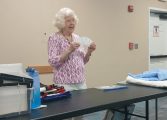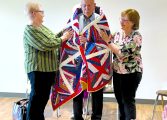Modern forms of decorative arts include fashion, interior, and graphic design. The label “decorative art” seems to be gradually fading away as it has always been closely associated with applied arts or crafts.
Decorative art has existed from early Greek and Japanese pottery to Celtic jewelry to the Renaissance, which began the fine arts movement as it recorded history through detailed paintings and symbolism in work far more serious than the decorative arts. But the Rococo School would highlight the importance of crafts, furniture, glass and textiles. Louis Comfort Tiffany was known as a craftsman but an artist as well for his use of stained glass. Art Noveau was an entire art movement after World War I that focused on everything from jewelry to furniture to graphic arts.
Fine artists usually learn to draw, then focus on a specific medium, such as oils, watercolors or pastels, whereas decorative artists often learn specific painting techniques, much like craftsmen, and work mostly in acrylics. But those who have spent years doing decorative painting are learning new techniques in watercolor or colored pencil. The fine art painter can learn detail, layering and patience from the decorative painter, while the decorative painter learns to loosen up, observe the natural environment, and use light and shadow to create emotion.
Janet Rugari, Loli Stams and Izzy Hickey are three local decorative painters who have also been successful in the fine art arena. Hickey and Stams were longtime members of PATL and are also members of the FAA. Stams is known for her flamboyant, bright, award-winning still life paintings and Hickey for her abstracts. Rugari went in another direction – though she still does painting her scratch board art shows her ability to do fine work.
At the Nov. 19 meeting of PATL, members Nancy Miner, who does face painting, and Brenda Lee Cohen, who is now learning watercolor from an FAA member, were painting a silk scarf. It was designed by decorative artist Beth Wagner, who is known for her murals, furniture, and trompe l’oeil.
Nancy Shaffer, who is a member, is one of many PATL instructors. Outside instructors are sometimes brought in for workshops as well. The workshops usually last all day, and the group is large and friendly.
First we dye the scarf, then paint the design with acrylics,” said Shaffer, who after nine years of painting says she’ll paint on anything from fabric to wood. Marilyn Hale, who heads up the group, always jokes about the fact that if it’s not nailed down it can be painted. However, they do have workshops focusing on traditional forms of painting such as watercolors and colored pencil.
“This was a new learning skill for us and was very popular with the group,” said Cohen, who has been with the group for three years and is still a newbie compared to Hickey who has been with them for 11 years.
Much of the work these women have created over the years features flawless craftsmanship and artistry from small glass pieces to ornaments to painted items like plates and boxes. Though everyone will create the same project, each stylizes it in her own way, giving it that personal touch.
“I have always enjoyed decorative painting in acrylics, as the medium dries fast and the finished projects make nice gifts,” said Cohen, who enjoys the practicality of her art.
For more information about PATL, contact Marilyn Hale at 434-589-6672.




